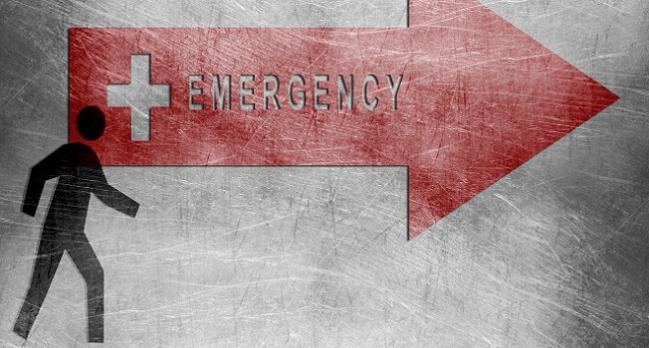Patients With Chest Pain Less Likely to Die After Discharge From High-Volume EDs
In an analysis of nearly half a million people, being seen in a busier ED was linked to better follow-up and more cardiologist contact.

The number of patients with chest pain seen in individual emergency departments (EDs) each year is an important predictor of subsequent mortality and hospitalization for ACS, new Canadian data suggest.
Looking at people presenting with chest pain and discharged after assessment in the Canadian province of Ontario, Dennis T. Ko, MD (Institute for Clinical Evaluative Sciences, Toronto, Canada), and colleagues found that at 1 year, 4.4% of patients seen in the lowest volume EDs had died or been rehospitalized for MI or unstable angina versus 3.1% of those seen in the highest volume EDs (P < 0.001).
“We very rarely think about the role of the ED in the long-term management and outcomes of patients,” Ko noted in an interview with TCTMD. Volume, he suggested, may be a surrogate for a variety of factors that contribute to more favorable outcomes later on.
“We are not certain why,” Ko observed. “But I do think there are some EDs that are busy and that are perhaps more organized in terms of discharge planning, consultation, and medication use that leads to better outcomes.”
In the study of 498,291 patients presenting to 179 Ontario EDs between 2008 and 2014, discharge from higher-volume EDs was associated with greater likelihood of cardiologist consultations on-site, and higher rates of cardiac medication prescriptions and cardiac catheterization within 30 days, than discharge from lower-volume EDs. Higher-volume ED discharges also were nearly twice as likely to receive echocardiography, ischemic evaluation, and follow-up visits with a specialist.
“I think it’s interesting that every time we look at a volume-outcome relationship it looks like the higher the volume, in general, the better the outcomes,” noted L. Kristin Newby, MD (Duke University Medical Center, Durham, NC), who commented on the study for TCTMD.
“There’s certainly something to be said for experience,” she added. “The more people you see, the more procedures you do, the better you are at teasing out real chest pain from an MI.”
Higher Volume Linked to More Cardiologist Consultations
As defined in the study, published October 23, 2018, in Circulation: Cardiovascular Quality and Outcomes, low-volume EDs saw a median of 449 annual chest pain presentations, while high-volume EDs saw about six times as many (2,651 annually). The majority of EDs (118 of 179) were classified as low volume, 29 as low-medium volume, 18 as medium volume, and 14 as high volume.
Compared with patients seen at other EDs, those seen at the high-volume EDs were more likely to have diabetes, hypertension, and dyslipidemia. Low-volume EDs were more likely than other EDs to have slightly older patients, and to see more patients from rural areas and with chronic obstructive pulmonary disease. Low-volume EDs also were less likely than other EDs to be teaching hospitals or have cardiac invasive capability.
Nearly half of patients presenting to high-volume EDs saw a cardiologist at the initial assessment (47.6%) compared with only 26.7% presenting to low-volume EDs. Stress testing was infrequent but slightly higher at high-volume EDs (1.2% vs 0.7%; P < 0.001).
By 30 days, 61.8% of patients discharged from high-volume EDs had seen a cardiologist for follow-up versus 35.4% of those discharged from low-volume EDs (P < 0.001). Patients discharged from low- and low-medium-volume EDs were largely followed by primary care physicians.
When outcomes were analyzed according to baseline risk, ED volume had a greater impact on high-risk patients than on low-risk patients. Whereas low-risk patients had similar rates of death or ACS at 30 days across hospital volumes, high-risk patients had rates of 1.8% for low-volume discharges versus 1.4% for high-volume discharges.
Analysis of hospitals by rural or urban location was consistent with the high volume, better outcome conclusion. The study also found that at an ED chest-pain volume of 100 patients per year, increasing annual volume by 100 was associated with a 6.0% reduction in odds of death or ACS at 1 year.
Options for Leveling the Playing Field
Ko and colleagues say their findings have policy implications with regard to optimal management of patients with chest pain, with one major message being to replicate the follow-up protocols of high-volume EDs in lower-volume EDs.
Newby added that it also would be interesting to see if the volume-outcomes relationship is blunted by performance improvement programs. Additionally, as hospitals convert to using high-sensitivity troponin testing, there is a possibility of “leveling the playing field” between low-volume and high-volume EDs, she added.
“The use of high-sensitivity troponin also brings in the element of an algorithm that’s done the same way every time . . . and you don’t have to be an expert to run through that and interpret it,” Newby observed. “[It] may not resolve the whole relationship, but I would bet it blunts that curve a little bit.”
Ko also said much more qualitative research is needed to try to understand specific limitations that may be causing patients not to be able to see a specialist for follow-up and determine what can be done to change that.
Newby cautioned that the findings need broader context and replication in US hospitals, where patient-access issues and referrals may be different than in Canada. Importantly, she added that the data should not be seen as discouraging for patients living in areas with only low-volume hospitals.
"It becomes challenging, because the message that we don't want to get out there is ‘drive an hour with chest pain to get to a higher-volume hospital,’ because that's also dangerous,” she said.
Another possibility for narrowing some of the gap between low- and high-volume EDs may lie in the use of telemedicine, Ko and colleagues note. To TCTMD, he said that smaller, remote hospitals without cardiologists on call may benefit from being able to run cases by a remote expert.
“We also are seeing more cardiologists doing telehealth-type medicine after discharge . . . to evaluate patients for cardiac testing,” he added.
L.A. McKeown is a Senior Medical Journalist for TCTMD, the Section Editor of CV Team Forum, and Senior Medical…
Read Full BioSources
Ko DT, Dattani ND, Austin PC, et al. Emergency department volume and outcomes for patients after chest pain assessment. Circ Cardiovasc Qual Outcomes. 2018;11:e004683.
Disclosures
- Ko reports being supported by a Clinician Scientist Award from the Heart and Stroke Foundation of Canada, Ontario Provincial Office.
- Newby reports no relevant conflicts of interest.


Comments